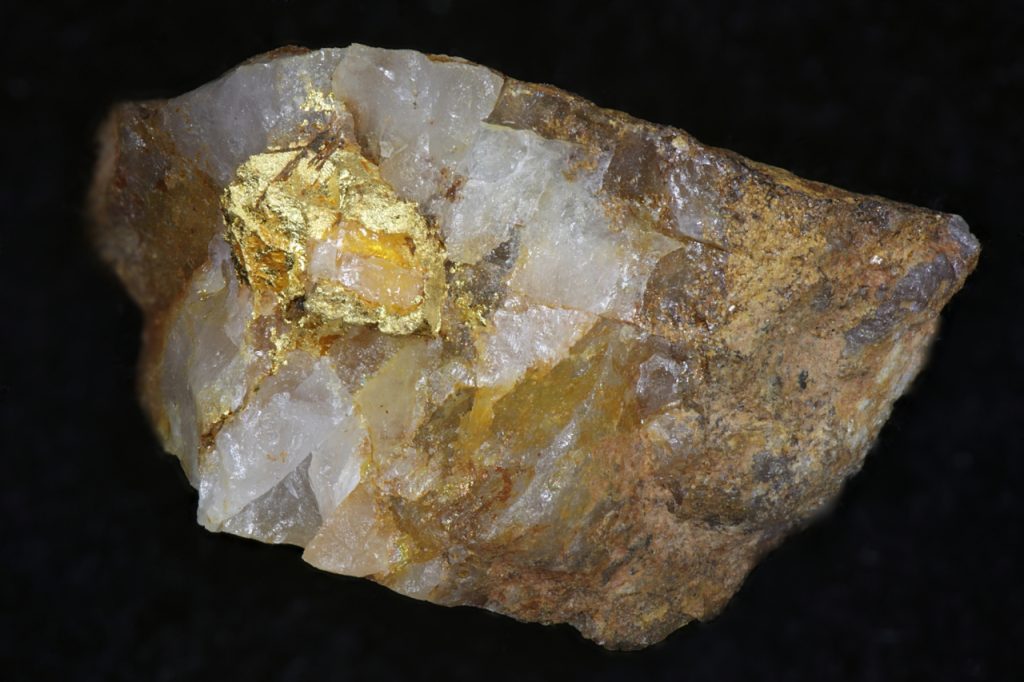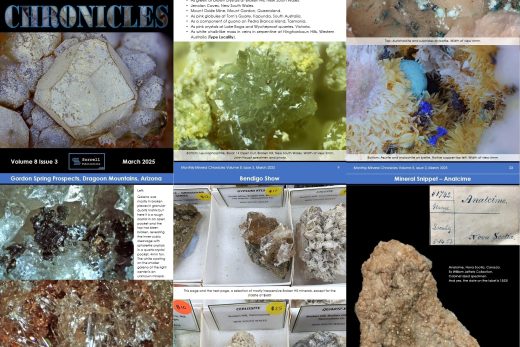Gold, n.:
“A soft malleable metal relatively scarce in distribution. It is mined deep in the earth by poor men who then give it to rich men who immediately bury it back in the earth in great prisons, although gold hasn’t done anything to them.“
Mike Harding, “The Armchair Anarchist’s Almanac”
Distribution of gold
Gold has been found over a large part of Victoria, with the most prolific producers being in the area known as the Golden Triangle in the central western region (Bendigo-Ballarat-Stawell) and in the east (Walhalla-Wood’s Point) and northeast (Beechworth). Each of the goldfields are generally attributed to provinces which are usually based on geological and geographical differences.
Victorian gold deposits have generally been regarded as Ordovician to Devonian in age and may have occurred during several different periods of mineralisation. Those in the Stawell region are found in unfossiliferous Cambrian or lower Ordovician sedimentary rocks, those in the Bendigo-Ballarat region in Ordovician sedimentary rocks, the Warrandyte gold fields in Silurian sediments, Walhalla-Wood’s Point in Devonian dykes, and those in the east in Ordovician sediments.
Chronological history of the discovery of gold
1823: First discovery of gold in Australia by a government surveyor named McBrien at Fish River in New South Wales.
1839: Count Strzelecki found gold at the Vale of Clwydd, New South Wales.
1847: Small gold discoveries in Port Phillip area, Victoria.
1851: Edward Hargraves starts goldrush at Bathurst, New South Wales.
1851: A reward offered for the first “official” gold discoveries in Victoria, resulting in alluvial gold finds at Warrandyte and Clunes.
The goldrush was on. Firstly in Ballarat, then Mt Alexander and Bendigo.
1853: A second goldrush occurred at Ballarat as the first deep leads were discovered.
1854: First reefs worked. Riots on the Ballarat goldfields. Eureka stockade stormed.
1856: Peak annual production reached.
1862: Alluvial gold found in Stringer’s Creek, Walhalla
1869: Welcome Stranger nugget found at Moliagul (2,284oz or 64.5kg).
1872: Quartz reef production takes over from declining alluvial production.
c1900: Western Australia displaced Victoria as the leading gold producer in Australia.
1980: The largest nugget to be found in Victoria for over 100 years was the Hand of Faith nugget found at Weddeburn (720oz).
Types of occurrence
Gold bearing (auriferous) reefs: Fractures in sedimentary rocks known as joints, are caused primarily through pressure. When they cross bedding planes they are known as faults. Quartz and other gangue minerals enter these fractures as hydrothermal solutions, impregnated with gold and sulphides. Many thousands of quartz reefs occur in the auriferous belts of Victoria, but relatively few carry gold, and in these, payable gold is usually localised. A saddle reef is an auriferous quartz reef situated at the crest of an anticline (see figure). Payable gold may occur in the saddles or the legs (extensions of the saddle) or in both. Saddle reefs have been mined in many of the goldfields including Bendigo, Ballarat, Castlemaine, Clunes and Blackwood, and gold can still be seen in a saddle reef underground at the Central Deborah Mine in Bendigo. “Indicators” were used throughout the state to find payable gold. Indicators differed from one area to another and included a black slate seam one eigth on an inch thick, a pyrite seam or even a quartz vein. Gold was usually found at the intersection of the indicator and quartz veins.
Alluvial: Gold that is found in gravels and sands, resulting from the erosion of gold bearing rocks, is known as alluvial gold.
Deep lead: A lead (ancient water course containing auriferous gravels) or placer deposit (alluvial deposit) in deeper ground, often overlain by basalt or younger sediments.
Nuggets: Nuggets are large masses of gold found in alluvial deposits. More than a dozen nuggets weighing over 1,000oz have been found in Victoria, including the Welcome Stranger, the largest nugget ever found. The majority of nuggets came from the Ballarat, Dunolly, Moliagul, Bealiba, Tarnagulla, Inglewood and Weddeburn goldfields.
Crystalline gold: Gold with definite crystal faces is rare in Victoria, but has been found ranging from microscopic size at Chiltern to crystals an ounce or more in weight at Ballarat and at a few other localities.
Mineralogy
Goldfields:
Glen Wills/Bendoc (includes Bethanga, Glen Wills, and Cassilis)
This goldfield has mainly sulphide rich ores, with a number of rare sulphosalts occurring. More thn 200,000 oz of gold and 150,000oz of silver have been produced from the Glen Wills field.
Harrietville (includes Beechworth, Harrietville, Bright, Chiltern, and Rutherglen)
Gemstone alluvials occur throughout this region with gems including diamonds, sapphires and zircons being found. In the Chiltern district, an extensive deep lead system was mined beneath a cover of 100m or more of younger sediments. A feature of these leads was their great width, up to 450m, and the presence of cassiterite.
For those that have visited the quiet town of Beechworth, it is hard to imagine that 64 hotels operated there in the 1870s.
Wood’s Point / Walhalla
Well known mines include the A1, Morning Star, All Nations, Thomson River, and Long Tunnel and Long Tunnel Extended. The Long Tunnel and Long Tunnel Extended mines in Walhalla, operated from 1865 through to 1914, having produced 820,251oz and 440,312oz of gold respectively. These mines both worked Cohen’s Reef, which was the largest single oreshoot in the State.
Minerals include sulphosalts, especially bournonite which was considered to be an indication of high grade ore at the A1 and Morning Star, galena, pyrite, arsenopyrite, and from the Thomson River Copper Mine, nickel and platinum minerals.
Gold from Wood’s Point contained 12-20 percent silver, and from Walhalla, 15 percent.
Melbourne District
Warrandyte, Ringwood, and Steeles Creek, were all associated with antimony. The Ringwood Council offices are now located on the site of the Ringwood mine.
There is a memorial to the first official discovery of gold close to Melbourne (at Warrandyte) and gold specs can still be panned from the creek.
Gold has also been found in the Yarra River and from deep leads in Collingwood. Brough Smyth’s ‘Gold Fields of Victoria’ (1869) lists a number of other Melbourne localities, the closest to the City being at North Melbourne. An interesting reference is to gold being obtained ‘in sinking the cellar of Mr Hancock’s house’.
Central Victoria (includes Heathcote, Costerfield, Whroo, Rushworth and Graytown)
The Heathcote goldfield is unique in that its eastern edge is of Silurian, its western side of Lower Ordovician, and its central area of Upper Cambrian age. Costerfield has yielded large quantities of antimony and gold and antimony are also associated at Heathcote, Whroo, Rushworth and Graytown.
Bendigo-Ballarat (includes Tarnagulla, Dunolly, Maryborough, Clunes, Ballarat, Maldon, Daylesford, Blackwood, Bendigo, Castlemaine, Chewton, and Fryerstown)
Bendigo-Ballarat-Stawell is known as the Golden Triangle, and has provided most of the gold in Victoria. The Bendigo field alone has produced around 40 percent of the total output.
Ballarat was famous for its alluvial gold, with the largest recorded yield from one day (excluding nuggets) of 2,832oz on 1st March, 1868. The second largest nugget, the ‘Welcome’ (2,218oz) was found in this region at Bakery Hill.
Maldon of course, is the type locality for a gold-bismuth alloy, maldonite, referred to as ‘smut’ by the miners.
Stawell (includes Ararat, Stawell, Avoca, and St Arnaud)
At Stawell, the ore is highly mineralised with up to one third of its volume consisting of pyrite, pyrrhotite and a lesser amount of arsenopyrite.
The St Arnaud area produced gold with a higher silver content than anywhere else in Victoria. Chlorargyrite and mimetite have been recorded from this area. Most, if not all of the dumps have been removed.
Associated minerals
The following is a list of many of the minerals found on the Victorian goldfields. This list is not exhaustive.
Native elements and alloys
antimony, aurostibite, bismuth, copper, diamond, electrum, gold, lead, maldonite, mercury, platinum, silver
Sulphides and sulphosalts
andorite, argentite, arsenopyrite, berthierite, bismuthinite, boulangerite, bournonite, chalcopyrite, cinnabar, galena, jamesonite, miargyrite, molybdenite, owyheeite, pyrargyrite, pyrite, pyrrhotite, sphalerite, stibnite, tetrahedrite, zinkenite
Phosphates and arsenates
apatite, hidalgoite, metatorbernite, mimetite, pharmacosiderite, pyromorphite, scorodite
Minor accessory and alteration minerals
anglesite, azurite, bismutite, cassiterite, cervantite, chlorargyrite, chromite, corundum, covellite, garnet, goethite, heulandite, kermesite, malachite, merenskyite, sperrylite, stibiconite, topaz, tourmaline, valentinite, wolframite, zircon
Gangue minerals
albite, ankerite, calcite, dolomite, quartz, siderite




